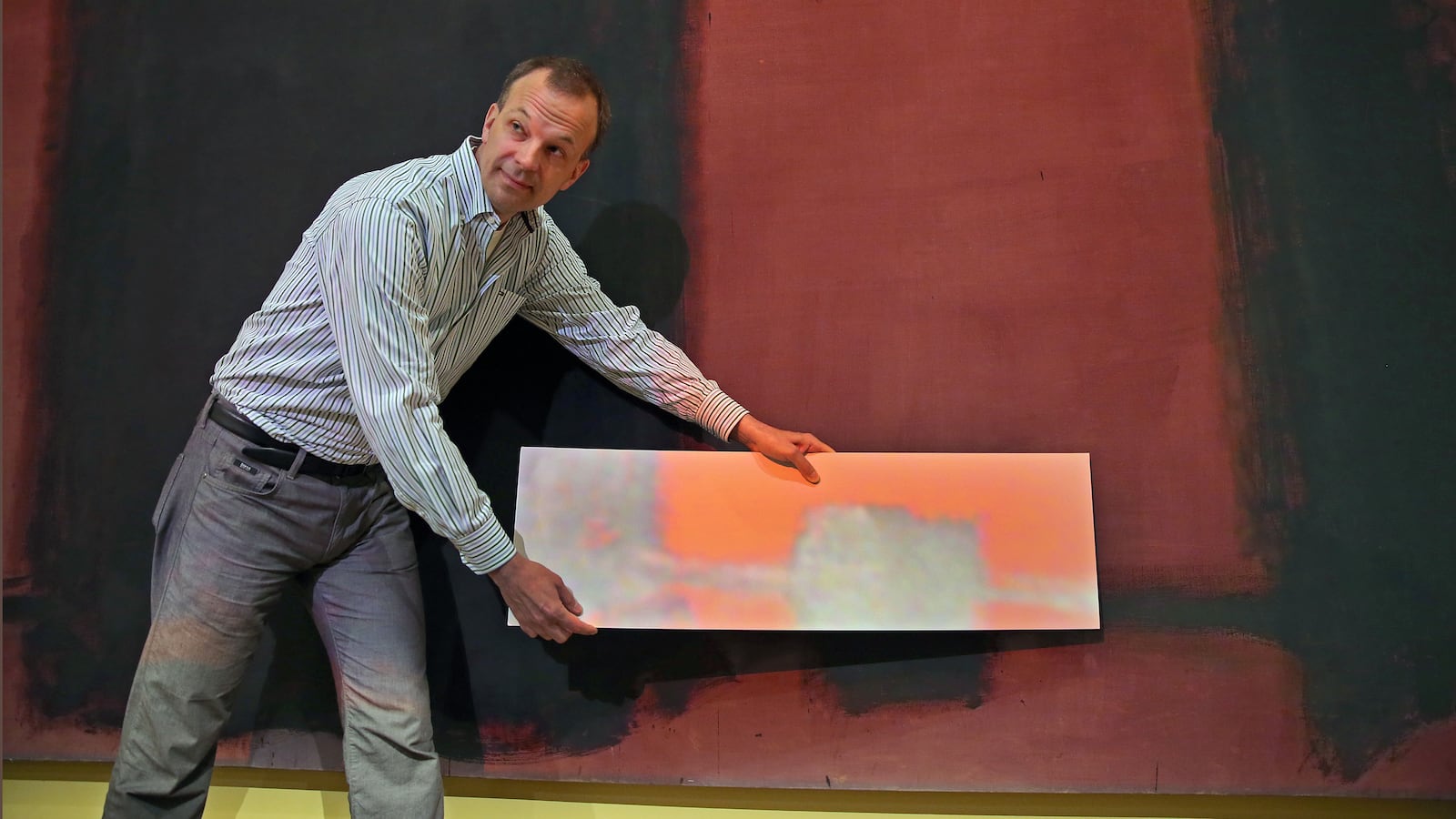In 1960, Harvard University commissioned the artist Mark Rothko, famous for painting monumentally scaled blocks of intense color, to create a site-specific work for the university. Rothko signed on to paint another in his series of “rooms,” massive canvasses sized to fit specific spaces, as he’d done for the Four Seasons restaurant in New York’s Seagram Building. At Harvard, the dons gave him a dining room on the top floor of what was then called the Holyoke Center, a modern building in Harvard Square, across the street from the Yard. The room had floor-to-ceiling windows, and Rothko agreed to paint a triptych to fill an alcove on the room’s west wall, and two more paintings to face them from the east.
An abstract expressionist, Rothko worked in fields of color, something of a hallmark of late-twentieth-century modernism. The color, either on a canvass or on the wall, would encompass the viewer’s entire field of view, an emotional experience that relied as much on how the viewer’s perception of that color changed over time as it did on whatever the painting actually looked like.
For Harvard, Rothko painted six canvasses and then chose which five to use on-site. He installed them there in 1963 and 1964. They all seem to represent doors or portals of some kind—dark, monumental, and foreboding. A couple curve inward slightly, conveying either a sense of decay and collapse or maybe something more organic. They’re all predominantly a plummy, luminous pur- ple color that Rothko, a skilled technician who often hand-mixed his own pigments, made from animal glue, ultramarine blue, and the synthetic pigment Lithol Red. That’s an “azo dye,” a synthetic substitute for the bluish-red alizarin, derived from the roots of the madder plant. (A dye, remember, is technically a pigment that bonds to some organic substrate, like wool or silk; if you add aluminum to alizarin, it’ll stick to that and become a “lake”—which is when you use a dye to color a pigment.)
Rothko often asked people who installed his “rooms” to keep the lighting low and use no furniture besides a bench, right in the middle, for people to contemplate the work. To that request Harvard said, Welp, this is a dining room, my friend. And so it was. Over the next two decades, people ate, drank, and smoked under those uninviting gateways. Thanks to the tenth-floor penthouse’s lovely view, it became a “party function room.” The paintings started showing tears and dents, and even some graffiti. Worst of all, the facility managers left the curtains open. Boston’s not the sunniest town in America, but the sun does come out, and that light, visible and ultraviolet, streamed into the party space.
That vivid Lithol Red screwed Rothko. The pigment books of his era insisted that it was a lightfast, colorfast pigment, but they were wrong. Dispersed into a binder and exposed to ultraviolet light, it faded. Mixed with ultramarine, it faded even faster. And Rothko had used titanium dioxide white to lighten his ground. In an organic binder like animal glue, and used with azo dyes, TiO2 turns into a photoreactive destroyer of all things colorful.
In 1979, the Rothkos—faded, damaged, sad—went into storage. People who saw the Harvard Rothkos at a 1988 exhibit described them as “irretrievably lost.”
Except… maybe not. We humans move through our brightly lit, brightly colored world with confidence. We don’t get confused when we see a fruit we like even if it’s in shadow; we aren’t startled by discord between our memories of objects and their colors when we reencounter them. That’s because of a slightly mysterious property of vision called color constancy—the ability to essentially subtract the color of the light bouncing off of an object from the color of that object itself.
To put it another way: Imagine what the world would be like if people didn’t have color constancy. You’d park a car in a lot in the morning and then return after sunset, when all the yellow-tinted mercury vapor lights are lit, and the car would be all but unrecognizable—except for its shape, license plate, and the crap in the back seat, of course.
Since color vision does rely, at least in part, on color constancy, well, that could actually solve some complicated problems. You wouldn’t even have to know how it worked, exactly—just that it works. You could fool the human eye into seeing a color that didn’t really exist.
Why would anyone want to run that scam? One possibility: rescuing art.
Today the Holyoke is called the Smith Campus Center, and it is about five minutes’ walk across Harvard Yard from the Fogg Museum. Since 1895, the Fogg has been a center for conservation and research into paints and pigments. In 1928 its director, Edward Forbes, started the Conservation and Technical Research Department, hoping to turn fine art conservation into a more rigorous discipline. That meant scientific analysis of pigments, and to that end Forbes started collecting samples from all over the world. Today that department and collection occupy the upper floors of the building that houses the Fogg, around a skylit atrium, with two stories and a glass roof added to the building during a remodel by the architect Renzo Piano. This is now the Straus Center for Conservation and Technical Studies, and its conservators subscribe to the same prime directive as their colleagues all over the world: Do as little as possible to a work of art to preserve it, and whatever you do, make sure you can undo it. If conservators could get away with it, they wouldn’t touch an artwork at all.
The centerpiece of the Straus is also one of its reasons for existing. A set of tall gray cabinets with glass doors runs the length of one side of the building, overlooking the atrium. It houses the pigment collection that Edward Forbes started.
The cabinets are a living infographic. Time runs along the Y axis, from the floor to the ceiling—raw materials are on the lower shelves, with pigments ascending upward, variations of the same color. And the X, the length of the hall, unwinds new color after new color, each one in its place. As we walk along that X axis, I remark on this to Narayan Khandekar, the director of the Straus, and he nods. “It’s like a color wheel that has been opened out,” Khandekar says. We’re walking in a literal colorspace.
I keep seeing old favorites, samples of things that up until then I’d only read about, and I can’t resist stopping Khandekar so I can snap pictures. Above white lead chunks are jars, phials, and flasks of all the other would-be white pigments, from powdered alabaster to calcined bone to titanium dioxide. They have dragon’s blood, a once-mysterious red from China, and Japanese agate that was ground into a pigment called memo. Next to parchment bladders once used to contain paint are examples of the first tin tubes that replaced them, the portability technology that made Impressionism possible. They have a real murex—the sea snail that got turned into Tyrian purple—from Phoenicia. A bag of beetle bodies that could be ground into cochineal. Madder root from Edward Forbes’s own garden. Sepia from a cuttlefish.
“Do you paint?” I ask Khandekar. He says he does—tiny streetscapes, little three-dimensional sculptural things.
“You’re steeped in it,” I say.
“It’s a whole different thing,” he says. “What I know professionally doesn’t inform how I do stuff with that.”
“No way. Really?”
“I mean, I know where to go when I need to solve a problem, but it’s not like I’m going, What’s the most stable, long-lasting pigment?”
“But,” I say, and gesture lamely at the cabinets.
“It’s not a collection of colors,” Khandekar says. “It’s a collection of pigments.”
I get what he means. There’s a difference between the idea of color and the technology of color, and Khandekar’s lab is one of the places that bridges the gap. Artists only use pigments because they’re playing with color, and pigments are the tools.
When the Rothkos were due to come out of dark storage once again in 2014, it was clear that nothing in the cabinet-timeline-colorwheel would help. Adding pigments to replace what the Rothkos had lost would fundamentally alter them, in color and in spirit. Cleaning or adding a glaze or varnish would, too. Conservators typically start by cleaning off old varnish, selectively removing it where it makes sense to lighten the colors behind it, replacing the smallest amounts they can get away with. Old paintings acquire a patina that’s part of their heritage. You don’t want to mess with that. But in order to create his subtle light effects, Rothko hadn’t varnished the paintings at all. That left them essentially unprotected; adding glaze now would darken the overall paintings and screw up the gloss/matte effects Rothko wanted.
So Khandekar knew that to save the Rothkos, he’d need a new approach—something so noninvasive it’d seem spartan, Zen-like in its hypothetical non-ness. “The Rothko project was a chance to do something for the first time,” Khandekar says. “Can you restore a work of art without touching it? As it turns out, you can.”
He got in touch with a physicist named Jens Stenger, and together they turned the problem on its head. They wanted to change a color. They weren’t allowed to change the pigment. So they would have to change the light.
The Harvard team planned to create an illusion—to put the “con” in color constancy. To be fair, this was all before the internet got broken by the Dress (blue and brown or white and gold?), so they had no idea that a color constancy violation could cause a memetic frenzy. They were really more worried about art critics.
The plan was to use colored light to restore the paintings to their original appearance. A conservator named Raymond Lafontaine had first tried it in the 1980s, beaming blue and white light at J.M.W. Turner’s Mercury and Argus and Lucas Cranach the Elder’s Venus to compensate for yellowed glazes added to both paintings. Lafontaine had come up with the idea as an aid to conservators, to show them what a work might look like after they cleaned it. But in the 2000s, museums and historical sites began to use the trick for objects on display, such as a damaged Renaissance mural in Germany and a Henry VIII tapestry outside London.
If the trick is going to work, you have to know what the art looked like when it was still mint. The conservators of the Henry VIII tapestry, for example, relied on the color of unfaded threads from its back.
Khandekar and Stenger didn’t have any hidden threads to pull on, but they did have Ektachrome transparencies, five-by-seven- inch pictures taken of the original Rothkos. But these were the wrong color too. Ektachrome was intended primarily for portraiture, so it has a bias toward warmer hues. Even if the transparencies had been in perfect condition, the colors they showed wouldn’t have been the ones Rothko had painted. And they weren’t in perfect condition. The printing process for Ektachrome, like any other color photography, involves dyes or ink in the primary colors cyan, magenta, and yellow, and the cyan in Ektachrome from the 1960s turned out to be unstable. It fades over time, shifting colors of the prints toward the other two colors. So the transparencies were as untrustworthy as the paintings themselves.
Except unlike the paintings, Ektachrome has a predictable, objective degradation curve. At the Imaging and Media Lab at Basel University, researchers scanned each transparency with red, green, and blue LEDs with peak wavelengths matching those absorbed by the dyes. Then they color-corrected these digital images according to a model based on the actual dye concentrations on the original transparencies and how their appearance had changed.

"Mary Schneider Enriquez, the Houghton associate curator of modern and contemporary art at the Harvard Art Museums, Narayan Khandekar, senior conservation scientist in the Straus Center for Conservation and Technical Studies at the Harvard Art Museums, and Jens Stenger, formerly a conservation scientist in the Straus Center for Conservation and Technical Studies at the Harvard Art Museums and now a conservation scientist in the Institute for the Preservation of Cultural Heritage at Yale University."
Boston Globe/Getty
"Mary Schneider Enriquez, the Houghton associate curator of modern and contemporary art at the Harvard Art Museums, Narayan Khandekar, senior conservation scientist in the Straus Center for Conservation and Technical Studies at the Harvard Art Museums, and Jens Stenger, formerly a conservation scientist in the Straus Center for Conservation and Technical Studies at the Harvard Art Museums and now a conservation scientist in the Institute for the Preservation of Cultural Heritage at Yale University."
Boston Globe/GettyKhandekar and Stenger also had a backup. Rothko had painted six pictures but only installed five at Harvard; his heirs still had access to the sixth panel, which he’d taken back to New York. Some of it had faded; some had not.
So the Harvard team had multiple points of reference. Now came the tricky part. They couldn’t just project the color-corrected images of the Rothkos onto the Rothkos. That’d be a slideshow, not an art exhibition, but more than that, the surfaces of the Rothkos already had faded Rothko on them; adding more Rothko wouldn’t work. The colors would interact and form all-new colors with nothing to do with the originals or the faded contemporary versions.
The researchers took another picture of the paintings, starting with neutral gray light made of red, green, and blue LED illumination. Then they compared that with the reconstructed digital images of the transparencies, creating a new, antimatter picture they called a “compensation image.” This became a guide to recalibrating the red, green, and blue output of each pixel on their projectors. Basically, they’d cast the exact right color of light at the exact right place on the painting to bounce off the aged, faded pigment and into people’s eyeballs, screwing up their color constancy and tricking their minds into seeing the original colors. “If you look at those projection maps, the maps of the missing color, they’re kind of crazy,” Khandekar says. “You have no idea how that color plus what’s on the painting is going to combine.”
It’s a Frankensteinian mash-up—the additive color of a digital projector and the subtractive color of pigments on a surface. The pigments had lightened, but “you can’t make something darker by shining more light onto it. And when you are painting, you often want to put more paint on to try to make it darker,” Khandekar says. “What we were doing was combining a map of the missing color and shining that onto the painting, which still had color. And so that combined reflection of the projected color and what was still existing on the surface produced an image of what the painting looked like.” In other words, the paintings didn’t look like them- selves anymore, and the compensation image didn’t look like the paintings, but when they shined the latter on the former, they had a 1964 Rothko.
Almost. They had to defocus the projectors a little, because each pixel has a thin black outline, usually invisible, but just slightly ap- parent at the wide scale of the mural. And despite all the mathematics they did to get the projections to register exactly with the paintings, they still had to tweak some of them manually, because the paintings themselves had changed shape a little bit, having been unstretched and restretched. Oh, and despite all this effort to replicate Rothko’s finicky matte/gloss action, the matte surfaces of the canvasses didn’t scatter light equally. That disrupted the match between the projection and paintings, especially when seen from an angle.
The paintings went on display, and were quite popular, but maybe not for the reasons Rothko would have hoped. People liked to show up around four p.m., when the museum would turn the projectors off, so they could see the transition from augmented to original. The altered work reflected its original appearance, but not the hand of its maker or the history of the canvas. It was, fundamentally, a constancy illusion—like the Dress, the new Rothkos were color- inconstant. Well, ceci n’est pas un Rothko.
One artist reportedly expressed disappointment at the whole project—light reflecting from a canvas was intrinsically different from the light that supposedly emanates from a Rothko. That’s probably artsy-fartsy pretension; paintings don’t emit light. I will allow, though, that some pigments, including alizarin—what Lithol Red simulates—reflect ultraviolet light as well as visible. While the human short-wavelength-sensing photoreceptor has a peak absorption at 426 nanometers, it has a long tail that reaches a bit into the almost ultraviolet, and individual human variation does allow some people to perceive blue light more intensely than others. Maybe—maybe—some people might have seen a fluorescent luminosity in the original pigments. Maybe. And it wasn’t there in the re-lit restorations.
Or maybe art critics are like audiophiles who hear nonexistent “warmth” in vinyl records and “clarity” from expensive cables. “Mark Rothko’s kids really liked it,” Khandekar says. “It works for some people. It doesn’t work for others. And, you know, I think that’s OK. We weren’t saying it’s the only way of doing it. In the end, you know, you turn off the projectors and the paintings haven’t changed at all.”

Excerpt from FULL SPECTRUM by Adam Rogers. Copyright © 2021 by Adam Rogers. Available now from HMH Books & Media. Reprinted by permission of HarperCollins Publishers. All rights reserved.






